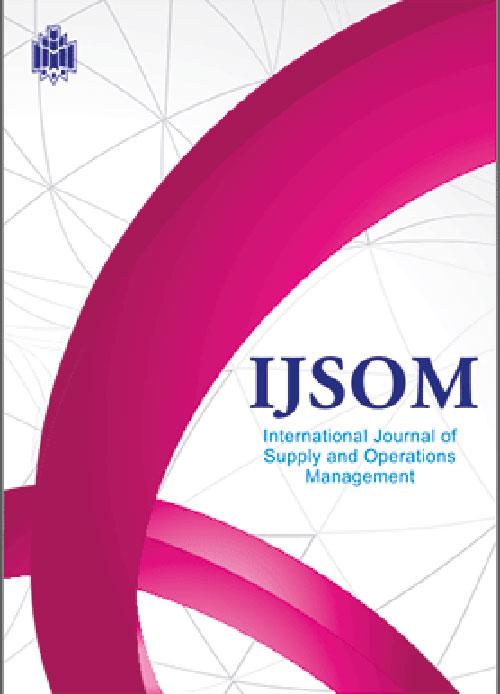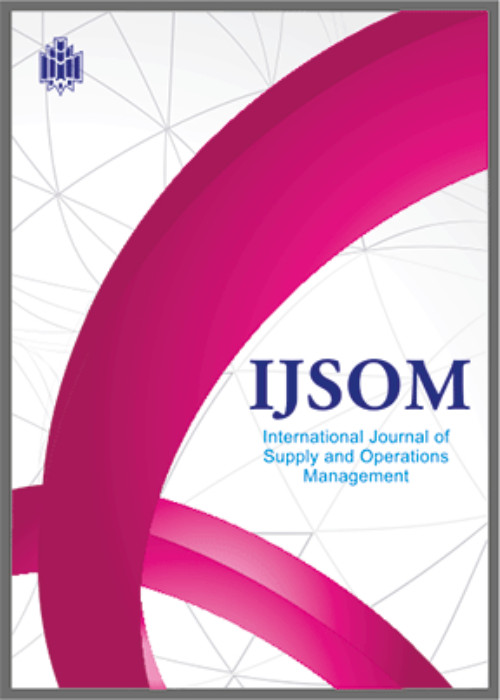فهرست مطالب

International Journal of Supply and Operations Management
Volume:7 Issue: 1, Winter 2020
- تاریخ انتشار: 1399/03/24
- تعداد عناوین: 7
-
-
Pages 1-16The production-inventory models are traditionally adopted for manufacturing systems. A relatively new area of production-inventory planning is related to livestock growing process. This research aims to propose a class of production-inventory model for new items titled growing items. In such a case, a rancher orders a quantity of newborn livestock like chicks or lambs, grow them to an appropriate weight during the growing period, slaughter them and then sells them to the meat market. The goal is to calculate the economic order quantity of the growing items at the start of a growing cycle, the optimal length of the growing cycle and the optimal total profit. We, in this research, extend the previous work to the case of joint growing and deteriorating items, where livestock grows at growing period, and, additionally, the slaughtered livestock may be deteriorated during the sales period. Moreover, since some amount of slaughtered livestock is waste and should be disposed, a weight reduction factor is considered when livestock is slaughtered. The inventory models are constructed for this case, a heuristic solution algorithm is presented, a numerical example is discussed, and finally, sensitivity analysis is carried out to investigate the applicability of the problem.Keywords: Production-Inventory systems, Growing items, Deterioration, Livestock, Reduction factor
-
Pages 17-38
Competition between supply chains of businesses reveals the importance of supplier selection and performance evaluation when the current state of the international markets and the global economy are taken into consideration. As in many other sectors, it is also very important for companies in the textile sector to use their resources more efficiently and constantly evaluate their suppliers in order to compete with their competitors. In this study, the performance of 16 common fiber suppliers of five different companies that are operate in one of subsector of textile sector namely the blanket sector have been measured and evaluated using fuzzy analytic hierarchy process (FAHP) and fuzzy data envelopment analysis (FDEA) methods. Criteria, which are weighted by FAHP method have been selected as the input and output variables to be used in FDEA. The fuzzy efficiency of supplier firms at different cut levels has been measured by FDEA. Efficient and inefficient suppliers have been identified as a result of efficiency measurement. Finally, a general discussion of the findings and directions for future research has been provided.
Keywords: Efficiency, Fuzzy AHP, Fuzzy DEA, Logistics, Supply chain, Textile -
Pages 39-50
Models of decision making optimization in the stock market have been challenged and evaluated by researchers in recent years. Financial and economic knowledge alone will not allow to analyze and facilitate decision making and to determine the appropriate strategy, and one of the most important obstacles in this regard is the complexity of tools and methods of analysis and modeling. The multiplicity of indicators and financial ratios on the one hand and the breadth of data on the other hand are the most important obstacles in the behavioral analysis of financial markets. Accordingly, the present study aims to model the decision-making process in financial markets. In this research, a different approach is presented in conceptual modeling by combining methods and tools of artificial intelligence with financial issues. Based on this, the portfolio will be optimized by extracting appropriate financial ratios considering the effect of time, and then modeling them in a technical expert system assuming a neutral risk investor. In addition to trying to conclude and analyze based on the realities of the stock market fundamental analysis, the system rules and the classification of companies are also distinguished from similar studies based on the dynamics of the stock market. The proposed model has been implemented using the data of companies in the real estate industry during 2007-2018. The results indicate the proper performance of the proposed model and that it has the appropriate flexibility to decide and select a portfolio.
Keywords: portfolio optimization, rule-based expert system, fundamental analysis -
Pages 51-75
In this research, a real case study of the natural gas supply chain has been investi-gated. Using concepts related to natural gas industry and the relations among the components of gas and oil wells, refineries, storage tanks, dispatching, transmission and distribution network, a seven-level supply chain has been offered and presented schematically. The aim of this paper is to optimize a case study using a multi-objective and multi-period model considering maximize the total revenue, minimize the economic and environmental costs, minimize the penalty per underutilized capac-ity and maximize the service level. A small-sized model was verified and solved using an improved augmented ε-constraint algorithm to generate Pareto optimal solutions and assessed trade-offs among objectives in order to help decision makers make an optimal decision. To the best of our knowledge, this is the first study that presents a multi-objective optimization model for the resilience and sustainable supply chain.
Keywords: Resilience, Sustainable, Supply chain, Multi-Objective, Optimization -
Pages 76-92Closing the supply chain loop at the end of a product’s life cycle is gaining popularity among researchers and practitioners because of its paramount influence on social and environmental issues. With the continuous adaption of the closed loop supply chain (CLSC) by developed countries, Bangladeshi automotive companies have given attention to CLSCs as a means of saving natural resources (energy, material, etc.) and reducing production costs. This paper proposed a structured framework using Delphi and fuzzy TOPSIS approaches for identifying and assessing major Bangladeshi automotive industry CLSC barriers. Through a literature review and extracting opinions from experts, a total of five major barriers and 16 sub-barriers were identified and evaluated via fuzzy TOPSIS. The result revealed that economic barriers were dominant for CLSC implementation in the existing supply chain followed by information-related barriers. This research may be a guideline to manufacturers when formulating strategic decisions and organizational visions for CLSC implementation.Keywords: Closed loop supply chain, Barriers, Fuzzy TOPSIS, Delphi, Automotive industry, Sustainability
-
Pages 93-111In this paper modelling maritimeinventory-routing problem for liquefied natural gas (LNG) under uncertainty of travel time is presented. We consider one hypothetical LNG manufacturer in Iran that sells its products in the form of long-term contracts and spots. The purpose of the study is to examine and compare the shipping costs of split and non-split delivery.The objective function is minimizing the operational costs, contract penalties, and spot fees, and the main constraints are liquefaction port constraints, ship flows, customer and contractual constraints. Considering uncertainty in the problem is one of this paper's contributions which is modeled by assuming vessels speed as a fuzzy parameter. The parameter and related constraints are defuzifided by Jimenez approach and for solving this problem a metaheuristic method is applied and effectiveness of results are compared with a commercial solver. According to the computational results split delivery policy in deterministic problem is cost effective but in the uncertain situation it is more costly comparing to non-split delivery policy, so split delivery is not recommended in maritime transportation with uncertain nature.Keywords: Marine Inventory, Routing, Uncertainty, LNG
-
Pages 112-118
Complexity of the enterprise innovative potential as a subject of research and its multifaceted nature cause a large number of approaches to its evaluation. Therefore, an urgent area of research is the development of a comprehensive approach that would promptly and fully diagnose the state of existing innovation potential of the enterprise. This article proposes a methodology for innovation potential evaluation is proposed, based on the resource and productive approaches to its measurement. In accordance with the proposed integrated approach, the following evaluation goals are identified: analysis of the efficiency of using innovative potential and determining the degree of relevance between the existing innovation potential and the selected enterprise development strategy (or new innovation project). As a result of the conducted research, the most informative indicators, characterizing the constituent elements of the innovation potential, have been determined, and on the basis of their use a method of calculating the final indicators of utilization efficiency and relevance of the existing innovation potential of the enterprise has been developed.
Keywords: Innovation potential, Management, Efficiency, Relevance, Factor analysis, Geometric addition method


